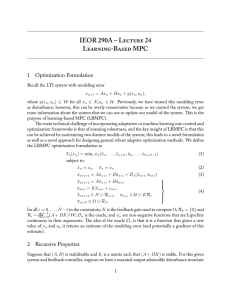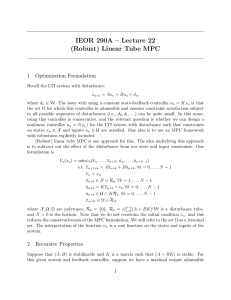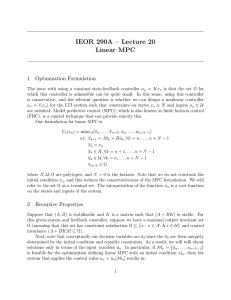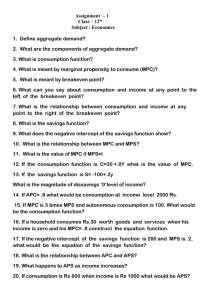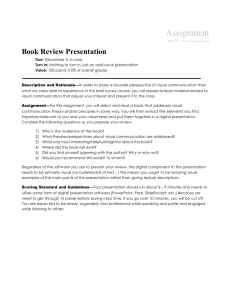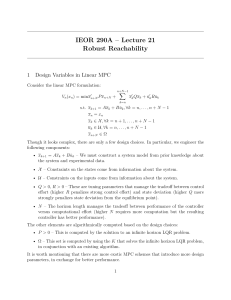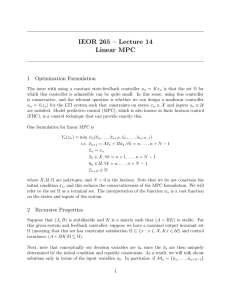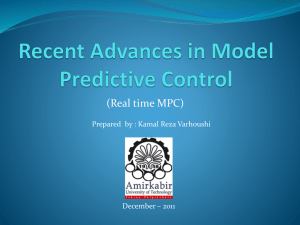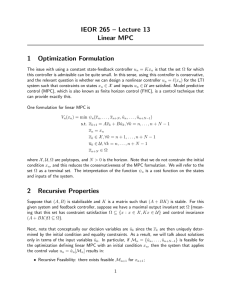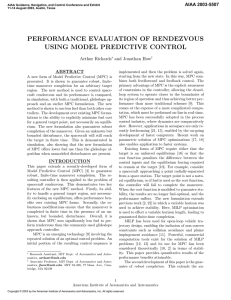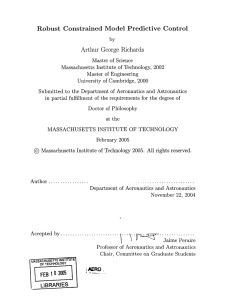IEOR 265 – Lecture 16 Learning-Based MPC 1 Robustness in Tube Linear MPC
advertisement
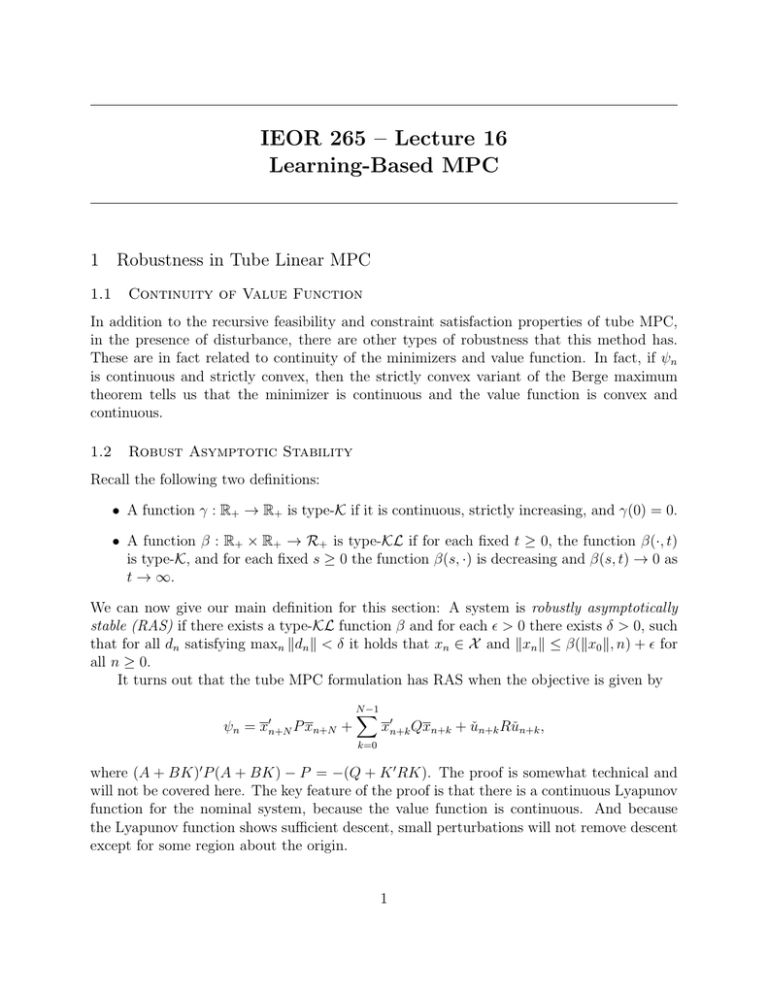
IEOR 265 – Lecture 16
Learning-Based MPC
1 Robustness in Tube Linear MPC
1.1
Continuity of Value Function
In addition to the recursive feasibility and constraint satisfaction properties of tube MPC,
in the presence of disturbance, there are other types of robustness that this method has.
These are in fact related to continuity of the minimizers and value function. In fact, if ψn
is continuous and strictly convex, then the strictly convex variant of the Berge maximum
theorem tells us that the minimizer is continuous and the value function is convex and
continuous.
1.2
Robust Asymptotic Stability
Recall the following two definitions:
• A function γ : R+ → R+ is type-K if it is continuous, strictly increasing, and γ(0) = 0.
• A function β : R+ × R+ → R+ is type-KL if for each fixed t ≥ 0, the function β(·, t)
is type-K, and for each fixed s ≥ 0 the function β(s, ·) is decreasing and β(s, t) → 0 as
t → ∞.
We can now give our main definition for this section: A system is robustly asymptotically
stable (RAS) if there exists a type-KL function β and for each ϵ > 0 there exists δ > 0, such
that for all dn satisfying maxn ∥dn ∥ < δ it holds that xn ∈ X and ∥xn ∥ ≤ β(∥x0 ∥, n) + ϵ for
all n ≥ 0.
It turns out that the tube MPC formulation has RAS when the objective is given by
ψn =
x′n+N P xn+N
+
N
−1
∑
x′n+k Qxn+k + ǔn+k Rǔn+k ,
k=0
where (A + BK)′ P (A + BK) − P = −(Q + K ′ RK). The proof is somewhat technical and
will not be covered here. The key feature of the proof is that there is a continuous Lyapunov
function for the nominal system, because the value function is continuous. And because
the Lyapunov function shows sufficient descent, small perturbations will not remove descent
except for some region about the origin.
1
2 Optimization Formulation of Learning-Based MPC
Recall the LTI system with modeling error
xn+1 = Axn + Bun + g(xn , un ),
where g(xn , un ) ∈ W for all xn ∈ X ,un ∈ U . Previously, we have treated this modeling error
as disturbance; however, this can be overly conservative because as we control the system, we
get more information about the system that we can use to update our model of the system.
This is the purpose of learning-based MPC (LBMPC).
The main technical challenge of incorporating adaptation or machine learning into control and optimization frameworks is that of ensuring robustness, and the key insight of
LBMPC is that this can be achieved by maintaining two distinct models of the system; this
leads to a novel formulation as well as a novel approach for designing general robust adaptive
optimization methods. We define the LBMPC optimization formulation as
Vn (xn ) = minc ψn (x̃n , . . . , x̃n+N , ǔn , . . . , ǔn+N −1 )
subject to:
x̃n = xn ,
(1)
xn = xn
(2)
x̃n+i+1 = Ax̃n+i + B ǔn+i + On (x̃n+i , ǔn+i )
xn+i+1 = Axn+i + B ǔn+i
ǔn+i = Kxn+i + cn+i
xn+i+1 ∈ X ⊖ Ri+1 , ǔn+i ∈ U ⊖ KRi
xn+N ∈ Ω ⊖ RN
(3)
(4)
for all i = 0, . . . , N⊕
− 1 in the constraints; K is the feedback gain used to compute Ω;
j
R0 = {0} and Ri = i−1
j=0 (A + BK) W; On is the oracle; and ψn are non-negative functions
that are Lipschitz continuous in their arguments. The idea of the oracle On is that it is a
function that given a new value of xn and un it returns an estimate of the modeling error
(and potentially a gradient of this estimate).
3 Recursive Properties
Suppose that (A, B) is stabilizable and K is a matrix such that (A + BK) is stable. For
this given system and feedback controller, suppose we have a maximal output admissible
disturbance invariant set Ω (meaning that this set has constraint satisfaction Ω ⊆ {x : x ∈
X , Kx ∈ U} and disturbance invariance (A + BK)Ω ⊕ W ⊆ Ω.
Next, note that conceptually our decision variables are cn+i since the xk ,x̃k ,ǔk are then
uniquely determined by the initial condition and equality constraints. As a result, we will
talk about solutions only in terms of the variables ck . In particular, if Mn = {cn , ..., cn+N 1 }
is feasible for the optimization defining LBMPC with an initial condition xn , then the system
that applies the control value un = Kxn + cn [Mn ] results in:
2
• Recursive Feasibility: there exists feasible Mn+1 for xn+1 ;
• Recursive Constraint Satisfaction: xn+1 ∈ X .
The proof is actually identical to that for linear tube MPC, because the learned model with
oracle are not constrained by X or U. There is the same collorary of this theorem: If there
exists feasible M0 for x0 , then the system is (a) Lyapunov stable, (b) satisfies all state and
input constraints for all time, (c) feasible for all time.
4 Continuity of Value Function
In addition to the recursive feasibility and constraint satisfaction properties of LBMPC, in
the presence of disturbance, there are other types of robustness that this method has. These
are in fact related to continuity of the minimizers and value function. In fact, if ψn and On
continuous, then the Berge maximum theorem tells us that the value function is continuous.
5 Robust Asymptotic Stability
Recall the following definition: A system is robustly asymptotically stable (RAS) if there
exists a type-KL function β and for each ϵ > 0 there exists δ > 0, such that for all dn
satisfying maxn ∥dn ∥ < δ it holds that xn ∈ X and ∥xn ∥ ≤ β(∥x0 ∥, n) + ϵ for all n ≥ 0.
Suppose Ω is a maximal output admissible disturbance invariant set, M0 is feasible for
x0 , and the cost function is
ψn =
x̃′n+N P x̃n+N
+
N
−1
∑
(x̃′n+k Qx̃n+k + ǔ′n+k Rǔn+k ),
k=0
where (A + BK)′ P (A + BK) − P = −(Q + K ′ RK), and lastly that On is a continuous
function satisfying maxn,X ×U ∥On ∥ ≤ δ. Under these conditions, LBMPC is also RAS. The
proof is technical, and the basic idea is that we compare the solution of LBMPC to the
solution of linear MPC (i.e., On ≡ 0). Interestingly, the proof makes use of the continuity
of the minimizer for linear MPC.
3
